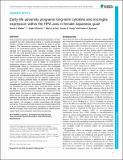Early-life adversity programs long-term cytokine and microglia expression within the HPA axis in female Japanese quail
Abstract
Stress exposure during prenatal and postnatal development can have persistent and often dysfunctional effects on several physiological systems, including immune function, affecting the ability to combat infection. The neuroimmune response is inextricably linked to the action of the hypothalamic–pituitary–adrenal (HPA) axis. Cytokines released from neuroimmune cells, including microglia, activate the HPA axis, while glucocorticoids in turn regulate cytokine release from microglia. Because of the close links between these two physiological systems, coupled with potential for persistent changes to HPA axis activity following developmental stress, components of the neuroimmune system could be targets for developmental programming. However, little is known of any programming effects of developmental stress on neuroimmune function. We investigated whether developmental stress exposure via elevated prenatal corticosterone (CORT) or postnatal unpredictable food availability had long-term effects on pro- (IL-1β) and anti-inflammatory (IL-10) cytokine and microglia-dependent gene (CSF1R) expression within HPA axis tissues in a precocial bird, the Japanese quail (Coturnix japonica). Following postnatal stress, we observed increased IL-1β expression in the pituitary gland, reduced IL-10 expression in the amygdala and hypothalamus, and reduced CSF1R expression within the hypothalamus and pituitary gland. Postnatal stress disrupted the ratio of IL-1β:IL-10 expression within the hippocampus and hypothalamus. Prenatal stress only increased IL-1β expression in the pituitary gland. We found no evidence for interactive or cumulative effects across life stages on basal cytokine and glia expression in adulthood. We show that postnatal stress may have a larger impact than elevated prenatal CORT on basal immunity in HPA-axis-specific brain regions, with changes in cytokine homeostasis and microglia abundance. These results provide evidence for postnatal programming of a pro-inflammatory neuroimmune phenotype at the expense of reduced microglia, which could have implications for central nervous system health and subsequent neuroimmune responses.
Citation
Walker , D J , Zimmer , C , Larriva Hormigos , M , Healy , S D & Spencer , K A 2019 , ' Early-life adversity programs long-term cytokine and microglia expression within the HPA axis in female Japanese quail ' , Journal of Experimental Biology , vol. 222 , jeb187039 . https://doi.org/10.1242/jeb.187039
Publication
Journal of Experimental Biology
Status
Peer reviewed
ISSN
0022-0949Type
Journal article
Description
This work was funded by the Biotechnology and Biological Sciences Research Council (BBSRC grant no. BB/L002264/1 to K.A.S., C.Z. and S.D.H.), a David Phillips Research Fellowship (K.A.S.) and an EASTBIO BBSRC Doctoral Training Programme studentship (grant no. BB/J01446X/1 to D.J.W., supervisors K.A.S., S.D.H.). Data are available from Mendeley (Walker, 2019): http://dx.doi.org/10.17632/ 6r7d2pg2zk.1Collections
Items in the St Andrews Research Repository are protected by copyright, with all rights reserved, unless otherwise indicated.

